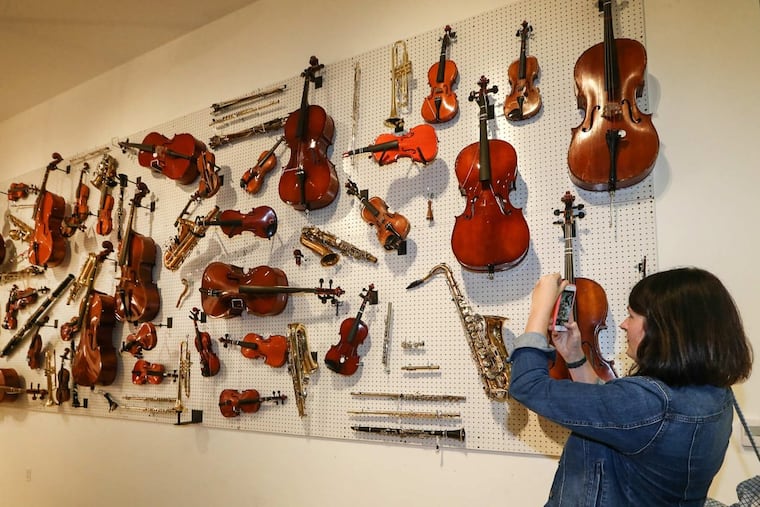'A desperate cry for help.' 400 busted Philly school instruments revived for Symphony for a Broken Orchestra
The project is part crowdfunding campaign to fix the instruments and part avant-garde music experiment, with a score from Pulitzer Prize-winning composer David Lang.

Su Spina normally plays kettledrums. But when she went to pick up the instrument she'd be playing in the Symphony for a Broken Orchestra — a new composition for 400 amateur and professional musicians all playing broken instruments from the Philadelphia public schools — her options were limited.
"Would you prefer a violin without strings? Or an autoharp?" Andy Theirauf asked her.
Spina, 22, a recent college graduate who studied music at Franklin & Marshall, said if knocking on a broken violin for 40 minutes is what it takes to get these instruments fixed, she's in.
"I started music when I was in elementary school," she said. "So, knowing a whole bunch of students in the Philadelphia School District don't even have access to instruments, I wanted to be a part of anything that helps."
The project — conceived by Robert Blackson, director of the Temple Contemporary art gallery — is part crowdfunding campaign to fix the instruments (adopt one at symphonyforabrokenorchestra.org) and part avant-garde music experiment, with a score from Pulitzer Prize-winning composer David Lang.
Its world premiere is Dec. 3 at the 23rd Street Armory. It is a one-night-only event: After that, the instruments will be repaired and returned to schools.
But, it may be the start of something even bigger.
"We've gotten many, many, many requests from school districts all around the country," Lang said. They want to perform his symphony with their own broken orchestras. "To me, that's a really beautiful thing — that it has given other people the opportunity to imagine how they can help to fix their own instruments."
The Inquirer and Daily News first covered the launch of the project in February. The work started with collecting the instruments, and cataloging the special way in which each one is broken: horns with stuck valves and long-lost mouthpieces; violins and cellos missing bridges, let alone strings.
Now, Lang's score is written, the musicians are hired, and rehearsals are underway.
Lang said that, as he began listening to the recordings, what became clear is that the instruments were unreliable. A broken trumpet couldn't be counted on to make trumpetish sounds.
"I wouldn't be able to write a beautiful melody where every instrument plays the melody and you hear them blend," he said. "So I designed a piece of music where the individual characteristics would come out and there's a lot of independence in what they do"
The score is a mix of musical notation and written English — a solution he devised when he was writing Crowd Out, his composition for a thousand community members who yell, sing, whisper and clap. Symphony for a Broken Orchestra is divided into 10 sections with headers like "punching chords" and "mysterious again, for a short while."
Altogether, it's an exploration of the capabilities of the instruments — and of the performers.
"Oftentimes, when you see a musical performance, it seems to happen effortlessly," Blackson said. "Here, the audience can connect to musicians because they can see that it's a struggle to play, and that struggle is part of the humanity of the piece."
The struggle got real for Kat Paffett, 39, during instrument distribution. She received a stand-up bass with no fingerboard, bridge, or case in which to bring it home.
Ben Mulholland, 35, was pleased with the French horn he received in a disintegrating case. "It's broken in interesting ways. You can make it into a weird, farty whistle."
As for Aidan Peterson, 11, a six-year veteran on the trumpet, he was confident.
"I know all I need to do is try my hardest and it will end up good," he said.
At rehearsals, though, the effort was evident.
Natalie Martin led a group of about 20 musicians through a call-and-response section of the symphony, her broken cello croaking and rasping like a singer who's long since worn out his vocal chords. Midway through the movement, half of someone's clarinet clattered to the floor.
Martin gave directions like: "Whatever the person next to you is doing, try not to start at the same time as them. It'll be like a real middle-school orchestra rehearsal."
Then, Evan Kassof took the musicians through a percussion movement, bows tapping on wood and keys clacking open and shut, but with variations in volume and tempo.
"Loud! Angry! You want your instrument fixed!" he told the group. "There's pain in here. We're the voice of these broken instruments."
Kassof, who has a doctorate in composition from Temple University, started playing cello in his middle-school orchestra. He believes this work is important, even in a school district with many other financial pressures.
"Just fix the damn instruments, and they'll fix the kids. A working cello will do a lot more than some new policy," he said.
Then, Anna Drozdowski, the project manager, sent the musicians home with brief instructions: "Please, don't try to fix your instruments at home. I know it's tempting, but we will engage professionals to handle that. Also: Please don't break them any more than they are already broken."
So, what will 400 broken instruments sound like?
"Mysterious," said Lang. "Powerful."
"A beautiful mess," said Drozdowski. "There are people as young as 9 and as old as 84 that are playing and there are people from almost every zip code in the city. That's a testament to Philadelphia's ability to come together around this issue."
Owen Brown, band leader of Urban Classical and a former member of the Sun Ra Arkestra, had a different take: "I think it's going to sounds like a desperate cry for help—which is exactly what's going on."